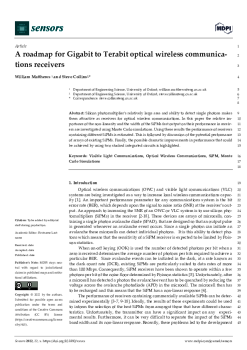A roadmap for multi-Gigabit to Terabit free space optical communications receivers
Paper
My Eleventh Paper
This work extends the previous paper on Monte-Carlo simulation of SiPMs, and explores what future SiPM receivers may offer.
Abstract
Silicon photomultipliers’ relatively large areas and ability to detect single photons make them attractive as receivers for optical wireless communications. In this paper, the relative importance of the non-linearity and width of SiPMs’ fast output in their performance in receivers is investigated using Monte Carlo simulations. Using these results, the performances of receivers containing different SiPMs are estimated. This is followed by a discussion of the potential performances of arrays of existing SiPMs. Finally, the possible dramatic improvements in performance that could be achieved by using two stacked integrated circuits are highlighted.
Key Findings
Results indicate that SiPMs with narrow output pulses are preferable for VLCs and OWCs receivers. The required irradiance for a specific BER increases quickly when the bit time is shorter than the output pulse width. SiPMs’ non-linearity must be considered, and it is recommended to operate them at a count rate below 40% of their maximum. Increasing the SiPM area reduces the irradiance needed for a given data rate, but it also increases the pulse width. The use of diodes to combine parallel SiPM outputs can avoid the trade-off between area and pulse width, but it can be costly. A change in transmitter wavelength from 405 nm to 850 nm has limited benefits. Stacked arrays of Single-Photon Avalanche Diodes (SPADs) show potential to significantly enhance receiver performance, surpassing existing fiber-optic communication receivers at 25.78 Gbps and enabling even higher data rates in the future.
